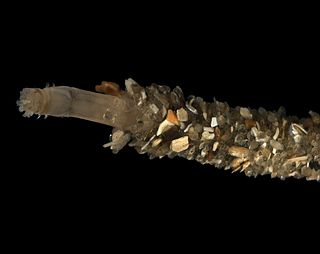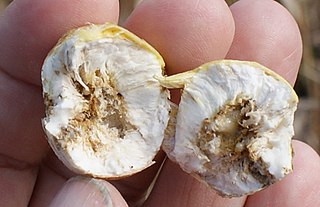
Balanoglossus is an ocean-dwelling acorn worm (Enteropneusta) genus of great zoological interest because, being a Hemichordate, it is an "evolutionary link" between invertebrates and vertebrates. Balanoglossus is a deuterostome, and resembles the Ascidians or sea squirts, in that it possesses branchial openings, or "gill slits". It has notochord in the upper part of the body and has no nerve chord. It does have a stomochord, however, which is gut chord within the collar. Their heads may be as small as 2.5 mm (1/10 in) or as large as 5 mm (1/5 in).

Nereididae are a family of polychaete worms. It contains about 500 – mostly marine – species grouped into 42 genera. They may be commonly called ragworms or clam worms.

Pectinariidae, or the trumpet worms or ice cream cone worms, are a family of marine polychaete worms that build tubes using grains of sand roughly resembling ice cream cones or trumpets. These structures can be up to 5 centimetres (2 in) long. The earliest pectinariid fossils are known from the Cretaceous.

Hesionidae are a family of phyllodocid "bristle worms". They are marine organisms. Most are found on the continental shelf; Hesiocaeca methanicola is found on methane ice, where it feeds on bacterial biofilms.

Pomatoceros triqueter is a species of tube-building annelid worm in the class Polychaeta. It is common on the north eastern coasts of the Atlantic Ocean and in the Mediterranean Sea.

Sabellastarte spectabilis is a species of benthic marine polychaete worm in the Sabellidae family. It is commonly known as the feather duster worm, feather duster or fan worm. It is native to tropical waters of the Indo-Pacific but has spread to other parts of the world. It is popular in aquariums because of its distinctive appearance and its ability to remove organic particles and improve water quality.

Chaetopterus variopedatus is a species of parchment worm, a marine polychaete in the family Chaetopteridae. It is found worldwide. However, recent discoveries from molecular phylogeny analysis show that Chaetopterus variopedatus sensu Hartman (1959) is not a single species.

Cirratulus cirratus is a species of marine polycheate worm in the family Cirratulidae. It occurs in the littoral and sub-littoral zones of the Atlantic Ocean.

Arenicolidae is a family of marine polychaete worms. They are commonly known as lugworms and the little coils of sand they produce are commonly seen on the beach. Arenicolids are found worldwide, mostly living in burrows in sandy substrates. Most are detritivores but some graze on algae.

Oweniidae is a family of marine polychaete worms in the suborder Sabellida. The worms live in tubes made of sand and are selective filter feeders, detritivores and grazers.

Palpata is a subclass of polychaete worm. Members of this subclass are mostly deposit feeders on marine detritus or filter feeders. Palpata has become superfluous with the elevation of Canalipalpata to subclass.

The Onuphidae are a family of polychaete worms.

The annelidas, also known as the ringed worms or segmented worms, are a large phylum, with over 22,000 extant species including ragworms, earthworms, and leeches. The species exist in and have adapted to various ecologies – some in marine environments as distinct as tidal zones and hydrothermal vents, others in fresh water, and yet others in moist terrestrial environments.

Scalibregma inflatum, also known as T headed worm, is a burrowing marine polychaete. It is a cosmopolitan species that can be found from the Arctic to Antarctica, although most probably several species are confounded.

Phyllodoce maculata is a species of Polychaete worm in the family Phyllodocidae. It is native to the northeastern Atlantic Ocean where it inhabits shallow water areas of sand, mud and stones.

Phyllodocidae is a family of polychaete worms. Worms in this family live on the seabed and may burrow under the sediment.
Eulalia clavigera is a species of polychaete worm in the family Phyllodocidae, native to the coasts around Britain, through Western France, and to the Iberian Peninsular. It closely resembles Eulalia viridis, and there has been confusion in the past as to the identification of the two species.

Scolelepis squamata is a species of polychaete worm in the family Spionidae. It occurs on the lower shore of coasts on either side of the Atlantic Ocean.
Leucia nivea is a species of polychaete worm, commonly known as a "scale worm", in the family Polynoidae. This species occurs in the northeastern Atlantic Ocean, the North Sea and the Mediterranean Sea.






















